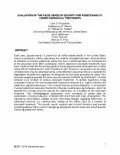-
Past ETC Papers

Browse, search and view papers from the past AET Conferences.
-
Members' Area

AET promotes networking and exchange of ideas, information and opportunities amongst members.
Conference Papers 2015
Frankfurt, Germany
ETC Conference Papers 2015
An Evaluation of the False Sense of Security for Pedestrians at Varied Crosswalk Treatments
Seminar
Day 2 (29 Sep 2015), Session 3, Advancing intersection design, 13:00 - 15:00
Status
Accepted, documents submitted
Submitted by / Abstract owner
Cole Fitzpatrick
Authors
Cole Fitzpatrick, University of Massachusetts Amherst, Ian McKinnon, TetraTech Inc., Dr. Michael Knodler, University of Massachusetts Amherst
Short abstract
This research seeks to determine the safest crosswalk treatments through direct observation of pedestrian and vehicle behavior at various crosswalk treatments.
Abstract
Pedestrian safety remains one of the most critical issues globally in transportation. Each year, approximately 12 percent of all traffic-related deaths involve a pedestrian, which underscores the need for immediate attention. At the forefront of initiatives to improve pedestrian safety has been a continued focus on enhancement of the crosswalk itself. More specifically, newer pedestrian crosswalk treatments have been implemented with the primary goals of improving crosswalk and pedestrian visibility along with increasing drivers’ yield compliance rates. However, increased levels of safety enhancements may be accompanied by unintended consequences that are related to the degradation of pedestrian vigilance resulting from an increased perception of safety. This research sought to quantify this false sense of security exhibited by pedestrians as a function of various crosswalk treatments. A specific hypothesis being evaluated is that as the level of crosswalk treatment increases (i.e., higher safety), the pedestrian vigilance decreases. This research had two primary objectives: 1) to ascertain if varied pedestrian crosswalk treatments influence specific crossing behaviors, and 2) to quantify the existing sense of security for pedestrians as a function of the crosswalk treatment. Two methodological approaches were employed to collect data on pedestrians’ crossing behaviors, including both direct field and video observations. The naturalistic observations yielded several interesting findings regarding differences in pedestrian behavior (i.e., look/no look, talking on the phone, etc.) as a function of crosswalk treatment. The overall results expand upon current literature and provide specific guidance that is useful in designing appropriate countermeasures aimed towards improving pedestrian safety.
Documents:

Association For
European Transport
Forester House
Doctors Lane
Henley-in-Arden
Warwickshire, UK
B95 5AW
+44 (0) 15 64 793552
VAT number: 710 1866 64
Conference Supporters & Endorsers




Legal Entity
The Association for European Transport is registered as an Association ('vereniging') with the Chamber of Commerce for Haaglanden in The Netherlands under company number 27170096.
Built on Zenario




